How To Install Garmin Maps From Computer To Device
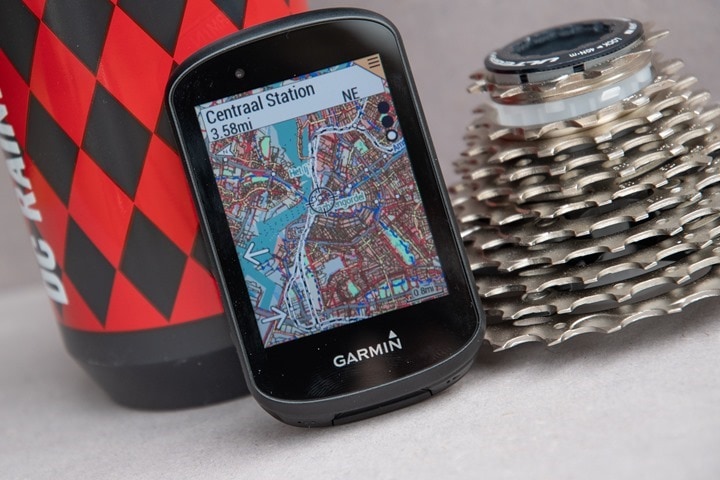
Last week I published a piece on how to install free maps on your Garmin wearable, which was a tweaked update of my vi-year-old mail service on how to install maps on your Garmin Edge devices. But every bit promised, I'd exist refreshing that old Edges-specific post too – which is what this new post is all about. It's most identical to concluding calendar week'due south mail and the one six years agone, except specific to the Garmin Edge serial because frankly information technology'll help people in Google trying to find Edge-specific instructions.
Things have certainly changed in the Garmin Border globe in vi years – nigh notably that all of Garmin's mapping capable Border devices now actually come with detailed maps for the region yous bought it in. Thus if you buy an Edge device in the The states you lot'll have North American maps, and if you buy it in Spain you'll take European maps, and if you lot purchase it in Sydney you lot'll take Australian/New Zealand maps. Detailed maps too – non the quondam and useless 'base map' junk.
But what happens when you traveled outside your region?
That'southward when you were back to the base of operations junk. That so-called base map has virtually no item in it. It might show a single dot for the entire city of Paris, or perhaps 1 highway leading into it. Certainly no usable streets or geographic landmarks.
Fright not – I've got y'all covered! You lot tin easily download costless maps on your Edge for when you travel. Quick and simple, and while the instructions might look long, the entire working time is probably nether 2-3 minutes for most people. I merely include a lot of pictures/text to get in super-clear.
I myself oftentimes use the freely downloaded variant I depict beneath (because I alive in Europe, merely often buy my units in the US). Or, for the European units I have when I travel to the U.s.a./Canada, like two weeks ago. And thousands of you every month do the aforementioned following these previously published steps. With that, allow'southward get into all the supported units and requirements and a few minor caveats below.
Requirements/Caveats:
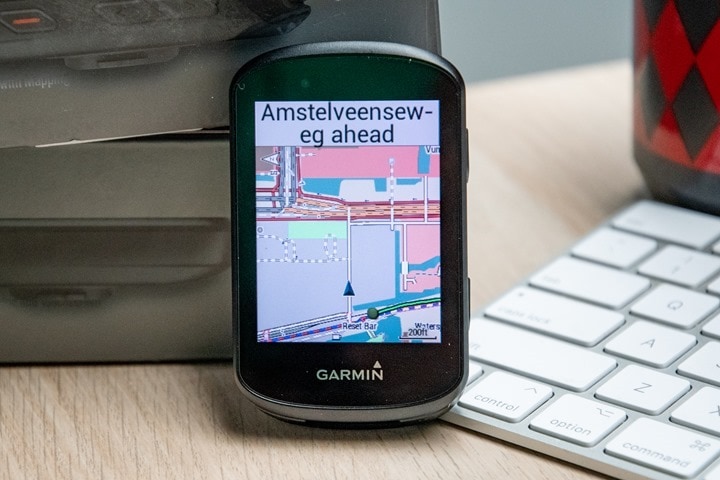
While this mail service probably looks long, it's mostly my attempt at answering any questions ahead of fourth dimension. In reality the entire process is super quick and easy. I'm just overly thorough in my screenshotting excitement. The actual active fourth dimension for you to exercise this is like 3-5 minutes tops.
You must take a computer – Mac or PC (or fifty-fifty Linux). You cannot practise this from an iPad or such. It's technically possible to practise it from an Android device with the right cables, just you're on your ain for that!
Every bit for compatible devices, here'south the list of devices this will work on. It also will piece of work on most of the handheld type outdoor devices also. If information technology supports Garmin maps, it'll support 3rd party maps.
Compatible Bike Computers: Edge 520 Plus/530, Garmin Edge 705, Garmin Edge 800/810/820/830, Garmin Edge yard/1030/1030 Plus/Explore/Touring variants (the base of operations Edge 520 is technically uniform, but just has a sliver of space on it, like, enough for one city), and the Bontrager Edge 1030 is totally fine too.
Compatible Wearables: Garmin Forerunner 945, Garmin Fenix 5s Plus, Garmin Fenix five Plus, Garmin Fenix 5X Plus, Garmin Fenix 5X (not-Plus), Garmin Epix (RIP), Garmin Descent MK1, Garmin MARQ Series, Garmin D2 Delta PX
At present you may be asking yourself, 'What if I have a non-Garmin unit? Will it still piece of work?' – and the short answer is basically no. There may exist some 3rd political party units that work with these maps, but nothing major. Plus, many other competitors like Wahoo, Stages, and Sigma simply brand information technology piece of cake for you to download maps without all this fuss.
Optional: Micro-SD bill of fare: If you lot've got an Edge unit that has a micro-SD card slot (namely the Edge 705/800/810/1000/1030/Touring/Touring Plus), you lot tin can place the maps on there instead to save space. More than on that in a minute.
Finally, since I know some of you will inquire, the following are most definitely *not* compatible. And the reasons are simple: They don't have the storage, or they don't accept the processing ability to handle maps. The transport has sailed on all of these (read: they're definitely not getting map support),
Not-Supported Bike Computers: Garmin Edge 20/25/130/200/500/510, and probably a few really sometime others.
Not-Supported Wearables: Garmin Forerunner 15/20/thirty/35/45, Garmin Forerunner 225/230/235/245, Garmin Forerunner 610/620/630/645, Garmin Forerunner 735XT/910XT/920/935, Garmin Fenix 5S/5 (non-Plus, non-X), Garmin Fenix three/3HR, Garmin Fenix (original), Garmin Vivo-anything, and countless others. Consider this just a 'starter listing' of non-supported units.
Note that while Garmin would adopt yous buy the maps from them, they really go out of their fashion to allow you to download free maps from tertiary political party providers. They simply note that information technology's unsupported (but doesn't void any warranties or such). Meaning that if the third party map data isn't perfect, information technology'due south not their error. But hither's the muddied clandestine: It'south the same underlying map data.
Terminal but not least – annotation that Garmin does add 'special sauce' to their maps – most notably what they call 'Trendline Popularity Routing', which is basically a variant of heatmaps. The main use for this is when you inquire the device itself to create a route on the fly (such as roundtrip routing) that it leverages heatmap data to give yous routes that people utilize more oftentimes. However, this is just applicable if you create/re-route on the device itself. You can still take advantage of that concept by just creating the routes on Garmin Connect or Garmin Connect Mobile first, which will use that same data from the cloud.
For almost all of Garmin's maps included on Border/Forerunner/Fenix/MARQ series devices, the base map itself is OSM (OpenStreetMap). What differs is some of the special sauce Garmin adds atop it (like heatmap blazon data), equally well equally the verbal layers Garmin does or doesn't display (how it looks, but besides things like topographic lines). In improver, at that place are some slight nuances to how the maps wait in terms of verbal styling. You'd never know unless you had the two side past side, which you'll see below. At left is what the default Garmin maps look like, whereas at right is what the free OSM maps expect like (the correct unit is only rotated xc°, considering that's the management the unit thinks I was going):
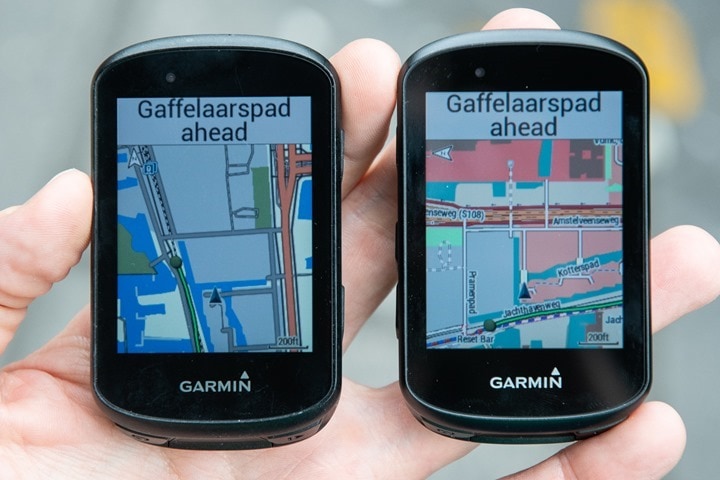
I observe the shading/clarity of the Garmin maps to by and large exist meliorate/optimized. Simply both are perfectly functional. Nevertheless, you also won't get topographic contour lines when using the complimentary maps. Technically speaking yous tin can download them and merge them together, but that'southward beyond what I'g going to comprehend hither.
Of course, I think it'south time for Garmin to motility onto the Wahoo & Sigma model of making it dizzy easy to download maps from other regions. Or heck, at least make it cheap. Charge me $10 per region (or even country), allow me to select the regions via my smartphone app – and and so go and download the maps via WiFi (Wahoo is the aforementioned process, except free). I'd happily pay Garmin $10 with a streamlined mobile-showtime strategy to get the heatmap and related information from them.
Part 1: Downloading the Maps:
This entire post is 'made possible past' OpenStreetMap, which are free customs-driven maps. OpenStreetMap has become in many areas just equally skilful as maps from traditional providers. And best of all, they're free. The below site but does all the hard work that you used to have to do manually a few years ago if you lot wanted to use OpenStreetMap. Now, it's literally as piece of cake as 1.ii.iii. Seriously, yous can do these clicks below in nether fifteen seconds.
Also – earlier I forget to mention, if y'all're on an Border 530/830, then the Trailforks mountain bike trail overlays are actually totally global, then you've already got the unabridged world in your pocket no matter which country you bought it in, and this won't negatively impact that i way or the other.
Commencement up, going to the site. Which, volition bring you here:

Notation that every in one case in a while that website goes down – as if someone didn't put enough coins in the slot. Information technology's a community-supported page after all. I'd strongly encourage yous to donate occasionally (even just $5, information technology saved you similar $100 anyway). I do. If the site is down, you tin use another site here. The downloading steps are slightly different (select Garmin BBBike equally the format, Map blazon OSM Mapnik), just ultimately all basically the aforementioned. I have no relationship to either site, it'south just what I've used for a long-long-long time at present. (Annotation: I've added some more sources at this section for cases where you lot might desire something a bit more unique/specific.)
Once the page loads, you'll want to select 'Routable Bicycle' as the map type.

Next, you'll select the region/surface area of maps you want. If you lot simply select a pre-defined expanse (similar a given country/state/province), so the site has already premade these for you, and then they are instantly available. Kinda similar picking upwards sushi from the case at the grocery shop (except less sketchy). Whereas if you want something custom – perhaps across multiple countries/borders, and so you can choose to create a custom map set.
If going for the preset sushi, you'll commencement by choosing your continent, so country. In some areas (such as the U.s.a. and Canada), you'll also choose the country/province. You'll come across that it automatically selects the coverage area in the map below.

If you lot don't need anything custom, then just click 'Download Map Now':

That'll bring you lot to this page. Select the 1 that the picayune MicroSD card icon side by side to it. DO NOT select the Windows, Mac, or Linux ones. It doesn't thing what computer you're using to download things, always-always-always select the one with the MicroSD carte icon (also titled 'GMAPSUPP.Aught' appended to the end of it).

Download and save that somewhere handy on your computer (similar your desktop) and skip ahead to the installation department!
[Again: Skip ahead to the 'Installation' bulleted section if you've simply downloaded your map!!!]
Whereas if you desire to roll your own custom map with added areas, then you'll select the checkbox titled 'Manual Tile Selection', and go from there. As a pro tip, if you're just adding a bit more territory to an existing predefined set, and then start past selecting that kickoff, and so checking the transmission option. As you tin meet below, I started with holland, and and then I checked the box and added a few more map tiles from Belgium/Germany/France onto the Southern portion of my Netherlands map:

Once you've selected everything you need to select, and so put your email accost in the little box and select 'Build my map':

The reason yous need to provide an e-mail accost is considering you lot get into a queue for the server to create your map. Like waiting for your proper noun to exist called at the DMV, except, more efficient. Hither's what it'll bear witness a 2d later:

And sure plenty, just as it says I'll instantly get an east-mail with my status:

And a few minutes after I get another e-mail service with the download link maxim it's set up. Usually that'southward all it takes. I don't think I've ever had to wait more than 10-15 minutes.

Just similar with the non-custom ones, select the 1 that the picayune MicroSD card icon next to it. Practice NOT select the Windows, Mac, or Linux ones. Information technology doesn't matter what figurer you're using to download things, ever-always-always select the ane with the MicroSD bill of fare icon (as well titled 'GMAPSUPP.Zip' appended to the end of information technology).

And again, call back that there'south a 'Donate' button on that site (I accept no affiliation with it). Apparently, good karma dictates that if you find their (free/community-hosted) service valuable, sending a couple of bucks their way is probably wise – particularly given how much money you're saving. Plus, it'll probably make that map creation bit go faster for custom maps if they go more support.
And finally, if you want some other map sources, a number of DCR commenters have listed their favorites, which I've included in hither. All of these maps basically offset from OpenStreetMap, so add details atop them. The main one I linked to above is simply one I consider pretty trustworthy and more than global in functionality. Whereas beneath some have specific areas they specialize in (and may prove more details for those areas), or take specific focuses (like peradventure better mountain bike detail):
– Topo-included map source: Frikart.no
– Topo-included map source, also POI's accept opening hours: OpenTopoMap.org
– Topo-focused maps that are also recommended for Africa: GMapTool.eu
– Cycling maps specialized for Netherlands/Belgium/Luxembourg with more detail: OpenFietsMap.nl
– Mount-biking focused maps: Openmtbmap.org
Once more, the above-listed maps are totally optional – and just additional sources.
Part Ii: Installing the Maps:
Installation of the maps is super easy. All you lot need to practise is put the file in the correct folder and you're expert to get. However, if you need to temporarily remove your maps, because y'all're tight on space, meet the optional Part Three below. About of the units we have here take enough space to add other region maps without having to articulate-cut first.
To put information technology into context, the Garmin default map data sizes (including some cycling-specific things) are roughly as follows (the maps yous'd go by default for the region you purchased information technology in):
Northward America: ~5.6GB including topo information
Europe: ~six.7GB including topo data
Australia/NZ: ~2GB including topo information
And infinite-wise, yous've got the following amounts of infinite on each device (minus the infinite required above for your base maps, plus a tiny bit for any courses/activities/workouts/etc…, usually 0.1-.3GB):
Garmin Edge 520 base: 0.05GB free (merely enough for ane urban center or a bunch of farmland)
Garmin Border 520 Plus: 16GB
Garmin Border 530: 16GB
Garmin Edge 810: 0.05GB gratis (simply uses micro-SD card for maps)
Garmin Border 820: 16GB
Garmin Edge 830: 16GB
Garmin Edge 1000: 8GB (plus micro-SD Card capable!)
Garmin Edge 1030: 16GB (plus micro-SD Card capable!)
Garmin Edge 1030 Plus: 32GB
Garmin Border Explore: 16GB
So yous'll desire to do simple math to see if everything fits. For context, the download size for the Netherlands from the free maps is 0.37GB (337MB) – so pretty pocket-sized. France is ~ane.4GB. Over again, should hands fit. But if you're tight on infinite, yous tin e'er follow the custom instructions above and take a prepackaged map similar France and make it smaller past removing areas yous don't demand (if you're staying in the Alps, you don't need the entire Western portion of France for example).
If you lot've got ane of the units to a higher place with a micro-SD Card slot, yous tin can follow the exact same directions, merely stick the maps in a folder called Garmin on the micro-SD menu. You tin can pickup a trustworthy 16GB card for a mere $five on Amazon (Reminder: When purchasing micro-SD cards on Amazon *always* ensure that it's both shipped from and fulfilled by Amazon itself, not a third party.)
In whatsoever event, let's install things. Starting time, connect your Border device to your computer using the USB cable it came with (since that allows transfer for data).
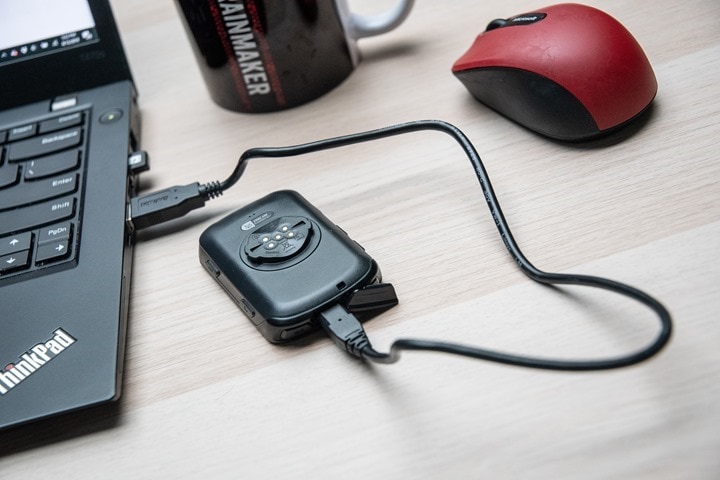
Get grab that file you downloaded (openfietsmap_lite_gmapsupp.nothing), and open information technology upwardly (just double-click it). This is what yous'll run across inside:

And then select that file and then select 'Copy'. Now simply paste that into the 'Garmin' folder on your watch. Do Non copy/paste the entire .ZIP file, you need the file within the zip file (like you see above). It's chosen gmapsupp.img and needs to go into the Garmin folder on your device.
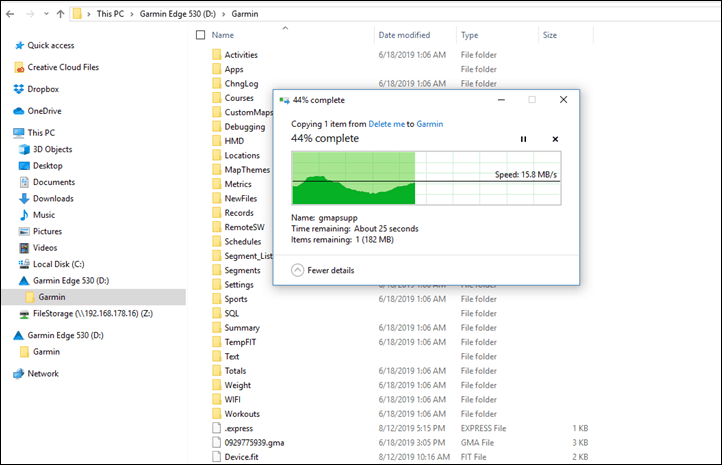
One time it's washed copying, yous should now meet that file sitting in the Garmin folder. The names volition be similar, but it's the one ending in 'supp' (like 'supplementary'):
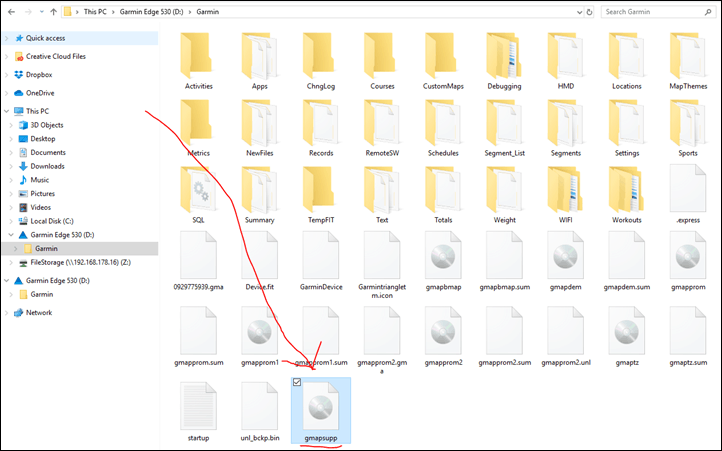
And with that, you're done.
Side note: Need to have two extra downloaded maps? Simply append the country proper noun to one of them to make it unique. Such as 'gmapsupp-france.img' and 'gmapsupp-netherlands.img'.

Information technology works perfectly fine.
Part III – Optional Space Savers Edition
This section is skippable unless yous're a hoarder and need to find a way to save some infinite on your device to make manner for other maps. I hateful, you might not be a hoarder, it might only be that times are tough and at present you've got more than maps than y'all know what to exercise with. As noted in the previous section, the maps that came with your device can accept up a bunch of space. And if you're headed somewhere that also has a large ol' map, then you might demand to temporarily offload the original map. Though again, that's pretty unlikely with any of the half-way recent units. Seriously, there should be almost no reason to exercise this section.
First though, earlier you do then – consider going with a smaller map. Significant, if you're going from the US to France, and only demand to ride in Paris – but download Paris only, and not all of France. Or if yous're going on a European trip to the Alps and thus recollect you need France, Frg, Italia, Switzerland, and Austria considering that covers your entire Alps region, endeavor instead just downloading a bunch of squares roofing the alps using the 'manual tile' mode. Like this (my selection below isn't perfect and definitely overshot a bit, simply y'all tin spend the actress few minutes to become information technology just right):
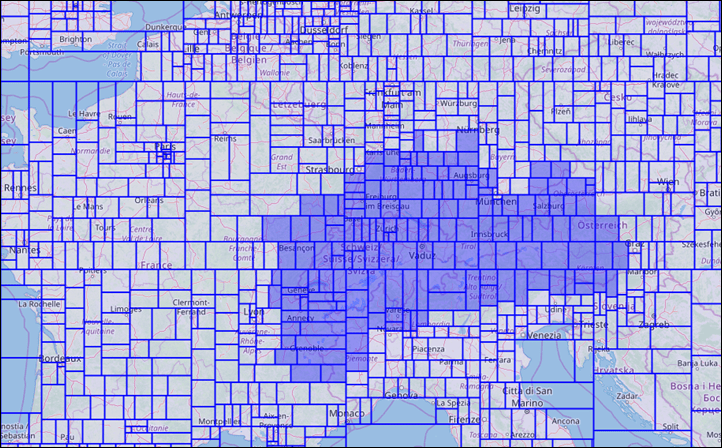
But, if all else fails – no biggie, taking maps off the Edge is super easy to exercise. I strongly recommend though *not* deleting them, and instead just doing a motility to your computer hard drive for afterward. Retrieve 'Cut' and 'Paste', not 'Delete'.
For the most part, the steps are identical to to a higher place, so instead of re-writing them, I'll simply tell you what to do differently. Permit's swoop right in!
1) Download the map section of involvement per the 'Office i: Downloading the Maps' section
2) Plug-in your Garmin Border to your calculator.
3) Within the Garmin binder on the Edge, you'll find a bunch of .IMG (image) files. These are the pre-loaded map and elevation files. Information technology tin can include whatever of the post-obit:
A) gmapbmap.img (base of operations map)
B) gmapdem.img (Digital Height Map, it's per-region)
C) gmapprom.img (pre-installed map file)
D) gmapprom1.img (another pre-installed map file)
You lot could mayhap take additional gmapprom #'south as well, if so, take hold of it. You're basically looking for the large files to make space. See the large file sizes below?
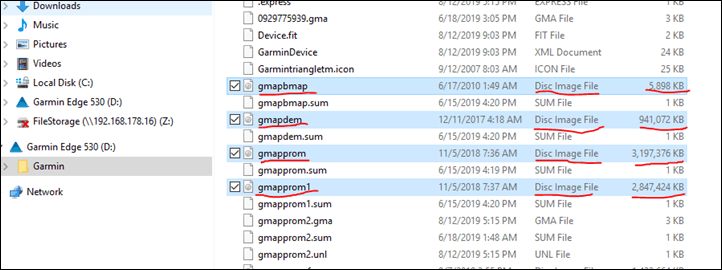
4) Cut and paste all of the higher up .IMG files to somewhere on your computer (create a binder chosen "My Garmin Maps" or something, just don't delete them).
v) Copy the gmapsupp.img map file y'all downloaded into the \Garmin folder on your Edge (or, if you're unsure, simply go back to "Part II: Installing the Maps" above and complete as normal. If you lot want to help yourself remember which is which later on, simply rename gmapsupp.img to something like gmapsupp-france.img or subsequently whichever land you're going to. You can name information technology anything you want – similar gmapsupp-dcrainmaker.img and that'll piece of work as well.
6) There is nothing actress yous need to practise on the Edge itself as far as configuring maps – information technology'll happen automatically, and so you can ignore Office 3 of the instructions. You're done, go exterior and ride!
And hey, there's a bonus to using this hoarder's road – you got the express lane for installation instructions. Only call up afterwards on that when you get dwelling house you'll demand to put dorsum the map file from your calculator onto your Edge device. To do so, simply copy the files from your calculator dorsum into place it into the Garmin folder on your Border and delete the gmapsupp.img file you added.
Function Four: Using the Maps:
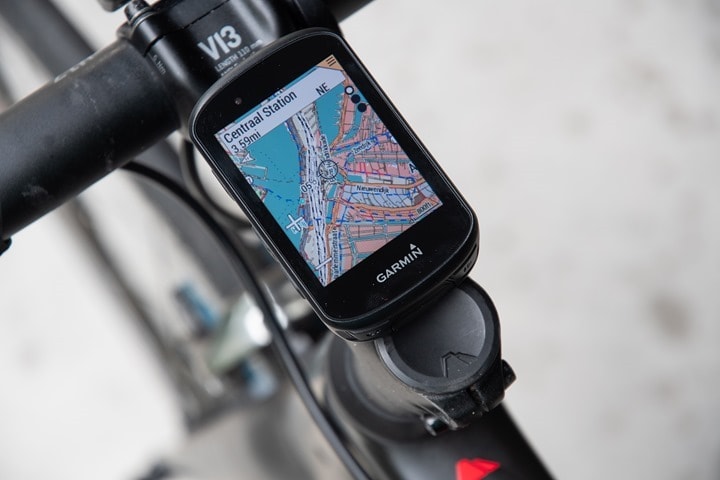
Actually, there's nothing you have to exercise here. In one case y'all've installed them they just piece of work. If you haven't added the map information page to your device, go into the action profile of your option (Settings > Activity Profiles > Choose your Activity Profile> Data Screens > Map>Ever
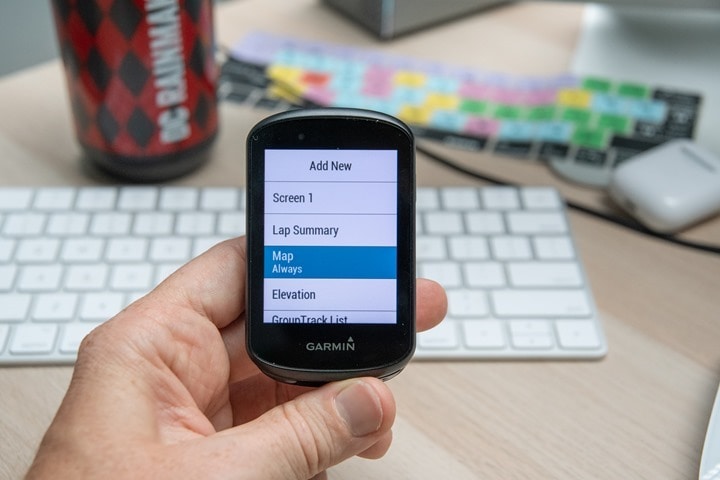
However, in the effect you want to turn off the downloaded mapset for some reason, it's pretty piece of cake to do (and yous tin ever delete that unmarried supp.IMG file if you demand the infinite after your trip.
To disable a given map though, become to Settings > Activeness Profiles > Choose your activity profile > Navigation > Map > Map Information/Select Map > Enable/Disable the map that y'all but loaded. Y'all tin come across below the Openfetsmap Lite-NLD, which is my Netherlands map, and below that my French map I added for France. While above it is the stock Garmin maps, in this example. By pressing the select button, it'll plough on/off the different maps. Super easy.
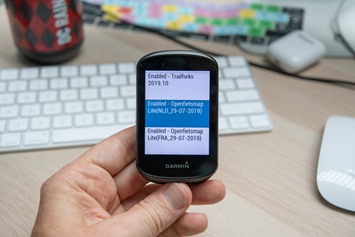

And in fact, every bit I mentioned earlier – for Edge 530/830 users, y'all can actually meet the global Trailforks map listed in there above (and if you actually wanted you can toggle it on/off). Or you can see information technology listed when you connect your device to Garmin Express (once y'all've activated it once, which is free). It covers you no matter where y'all go:
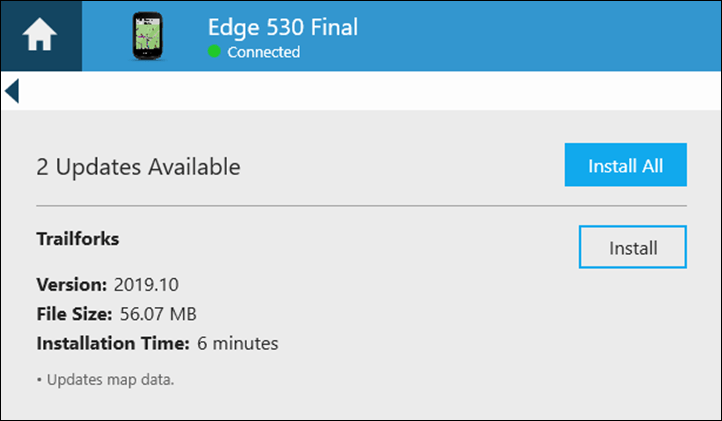
And that's it! Yous'll be able to employ these maps as normal. That includes things like height details for courses, planning between points, points of interest, specific addresses, and round trip routing. Enjoy!
As always, thank you for reading. And if you plant this mail helpful – consider condign a DCR Supporter, I appreciate information technology!
Source: https://www.dcrainmaker.com/2019/08/how-to-install-free-maps-on-your-garmin-edge.html
Posted by: palmasulard.blogspot.com


0 Response to "How To Install Garmin Maps From Computer To Device"
Post a Comment